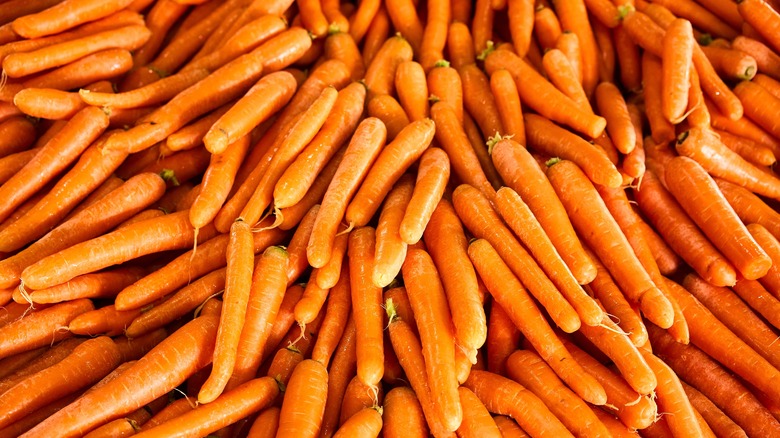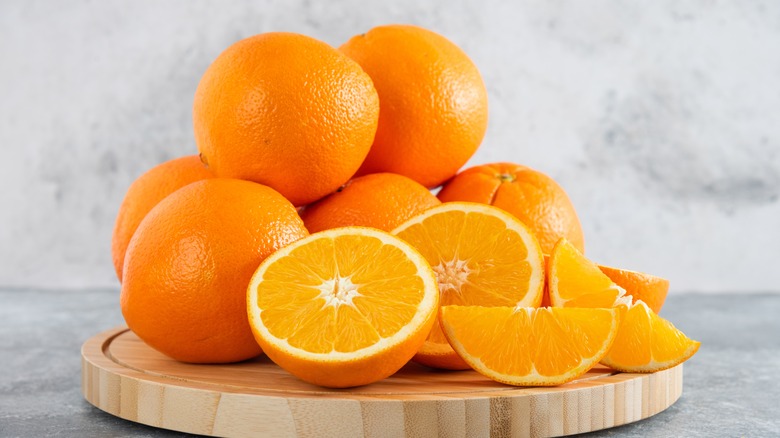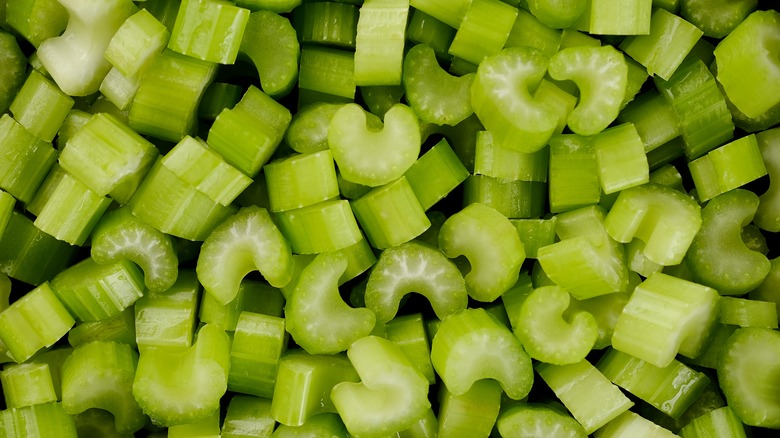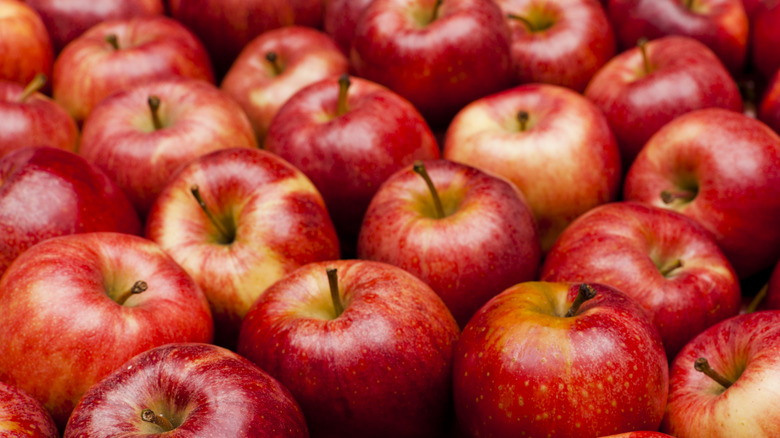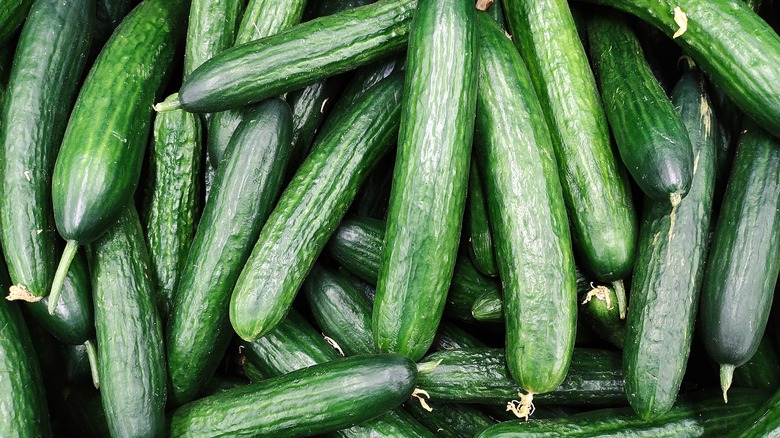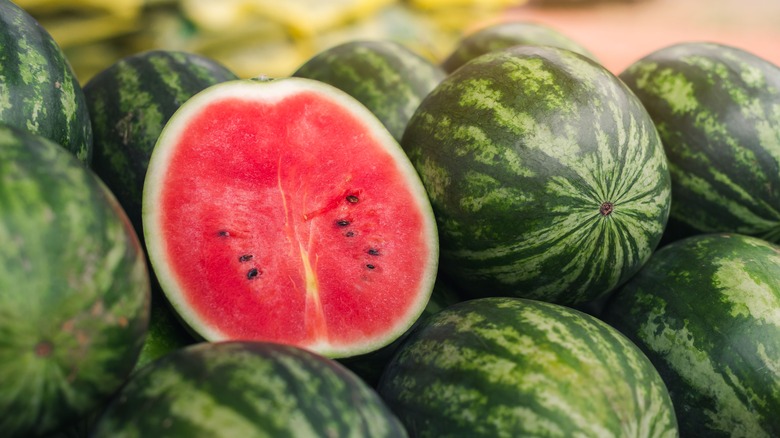14 Cheapest Fresh Fruits And Vegetables You Can Find At The Grocery Store Year-Round
You're not just imagining it: Food prices at the grocery store are at an all-time high. According to the U.S. Government Accountability Office, grocery prices jumped 11% from 2021 to 2022. For reference, food prices generally only increase 2% per year, so it's not hard to see why so many people are struggling to afford the groceries they once had no problems putting on the table — especially since stagnant wages continue to prevent workers from making the money they need to survive. Although prices are expected to increase less drastically in 2023 than they did in the year prior (the USDA Economic Research Service predicts food prices will rise by 6.2%), it looks like those high prices are here to stay for the foreseeable future.
For some of us, food banks may be the answer to getting food on the table every night. For others, it's more about understanding how to cut our grocery costs without feeling like we're depriving ourselves. Knowing which foods to buy plays a huge role in meeting your monthly food budget. If you want to avoid a lot of the processed stuff and are looking for more whole food items that won't break the bank, check out these affordable fruits and vegetables that you can find at the grocery store all year round.
Carrots
If you're looking for a healthy whole food option at the grocery store that will help stretch your dollar, there are few vegetables better than carrots, which the USDA categorizes as a "lower-cost" vegetable. On average, a one-pound bag of carrots costs only slightly more than a dollar, making them a great deal for most shoppers, per the USDA.
Carrots can be used in many different ways for a wide variety of dishes. You can roast them or sauté them on their own, or blend them into nutritious creamy soups. Add them to stir-fries or cut them into matchsticks so you can add them to a salad. If you're not a fan of how sweet carrots are, try quick-pickling them to balance out that sugar. There are so many different ways to eat them that carrots can easily become a low-cost staple in your kitchen.
Generally, peeled baby carrots are going to cost more than their unpeeled counterparts, so if you're trying to save as much money as possible, buy whole carrots instead.
Cabbage
Another easy-to-find vegetable that the USDA considers a lower-cost vegetable option is the humble — but very delicious — cabbage. At just under 70 cents a pound, per the USDA, it's one of the cheapest veggies you'll find in the produce section. The best part? A big cabbage is going to provide you with a lot of food and a lot of nutrition. And like carrots, cabbage can be used in a wide variety of dishes, whether you want to sauté it as a side dish or add it to soup to add some bulk to the dish. Another great idea is to finely slice your cabbage and make it into a simple and easy slaw – just add it to sandwiches and pasta salads.
Don't like the flavor of green cabbage? Not a problem — you may like red cabbage better. Since they're similar in price, you can snag either to add to your meals for the week.
Potatoes
The USDA has a helpful tip for anyone trying to stretch their dollars at the grocery store: Choose starchy vegetables. And there is perhaps no greater starchy vegetable available than the potato. As of May 2023, the average American can snag a 10-pound bag of potatoes for less than $4, per the USDA. Potatoes are among the most versatile of ingredients you can keep in your house, and they keep you feeling full for hours on end.
If you want to keep things as simple as possible and you don't have a ton of time to cook, consider making a baked potato. You don't even have to turn on the oven — just poke some holes in your potato and cook it in the microwave. But of course, you can turn potatoes into just about anything, from mashed potatoes and gravy to hash browns to french fries to scalloped potatoes. Use them to add calories and carbs to your meal.
Oranges
Fruits can often be significantly more expensive than many of the veggies you'll find in the produce section, but that doesn't mean you have to succumb to scurvy. Some fruits are on the cheaper end of the spectrum, and luckily for all citrus lovers out there, oranges tend to be one of those fruits. The average orange costs less than a dollar, per the USDA, making it a relatively accessible fruit even for those with tight grocery budgets.
Some people don't love oranges because they've only ever eaten them on their own, but there's much you can do with this citrus fruit. Of course, you can always juice it and enjoy it at breakfast, but you can also add it to salads or use the juice to marinate chicken or pork. Plus, if you're out of lemons and limes, it can add a touch of acidity to dishes that need it (just expect it to add a bit of sweetness as well).
Bananas
We love berries, but that doesn't mean we can always afford them when we go to the grocery store. If you're looking for a cheaper fruit option, you should add some bananas to your basket. They're among the least expensive types of produce you can buy, at just 51 cents a pound on average, per the USDA. Bananas provide a decent amount of calories per serving, which is why a banana makes for an excellent quick breakfast on the go. Slice it up and add it to toast with peanut butter for a filling, complete meal to start your day.
Craving ice cream but don't want to spend extra money on a dessert? Use bananas to fulfill your cravings for sweets by freezing them, then blending them with some cocoa powder and honey or sugar. The bananas will form a thick, ice cream-like texture that's hard not to love if you're already a fan of bananas.
Celery
It's important to get plenty of green veggies on your plate, which means you want to fill your fridge with as much green as possible. That can get expensive if you're mainly opting for kale and arugula, but there are green veggies out there that can stretch your dollar. Celery is one of our favorites, considering that as of May 2023, a pound of the stuff only costs $1.68, per the USDA.
Like so many of the veggies on this list, there's a lot you can do with celery. It's worth keeping some on hand just to have something to snack on (with or without some peanut butter), but it's also a great addition to soups and chicken salads. If you're looking for a way to add more crunch to your diet, or you're just looking for a refreshing veggie to liven up your meals, you can't go wrong by grabbing some celery.
Apples
Another cheap option for the fruit lovers out there is apples. The USDA says that apples are one of the lower-cost fruits out there. However, when you're shopping for apples, you should take a close look at the prices for each individual variety. Some types of apples require more intensive farming practices than others, and some may have to be shipped from farther away, both of which can raise the price. However, in general, apples will be one of the cheaper fruits available in the produce section.
Apples aren't quite as cheap as bananas, but they're still relatively inexpensive, typically coming in at between one and two dollars per pound, per the USDA. Eat them on their own for a quick snack on the go, or add them to your oatmeal in the fall for some extra flavor. Don't forget to use them in apple-based pies like desserts and galettes as well.
Honeydew
If you're looking for cheaper produce at the grocery store, it may surprise you that honeydew melons tend to be on the less-expensive end of the spectrum. Of course, that comes with a caveat. While these melons are often packed with nutrients, they also won't provide the amount of calories that you'll get from other fruits, like bananas. Regardless, most melons are budget produce, which is why there's nothing wrong with picking up some honeydew from the store every once in a while. On average, honeydews cost less than a dollar a pound, per the USDA, making them a seriously good — and refreshing — deal.
Cutting up some melon and eating it on its own makes for a healthy and cooling side dish, but that doesn't mean you can't combine your honeydew with other ingredients. It's delicious as part of a fresh fruit salad, especially when it's combined with other types of melons.
Cucumbers
There are few vegetables as refreshing and hydrating as cucumber, which is why many people love to have some in the fridge, especially during the hottest months of the year. Luckily, it doesn't cost much to keep it stocked in your kitchen, coming in at just 72 cents as of May 2023, per the USDA. You're not going to find many other veggies for that price, so it's something you can always have around when you need your vegetable fix.
Wondering what to do with your cucumbers, besides slicing them up and eating them with salt? Chop them up along with some tomatoes and red onions to create a quick summery salad, or add them to cottage cheese for an easy savory breakfast. You may also like marinating them in a combination of soy sauce and chili oil, either to enjoy on their own or to eat with rice. Even if you don't like cucumbers on their own, the flavor is mild enough that you can adjust it to your liking with different spices and seasonings.
Watermelon
Most melons tend to be cheaper than many of the other fruits in the produce section, which is why it's always a good idea to pick out a giant watermelon to take home, especially during the summer when they're in season. Even if you're normally not a fruit person, there's a good chance you like watermelons — their subtle sweetness and incredibly juicy flesh make them hard not to love. On average, they'll cost you just over $6 each, per the USDA. Yes, that may seem like a lot compared to some of the other types of produce on this list, but you have to consider that you're getting a lot of food when you buy a watermelon.
On a hot day, there's nothing like cutting into a fresh watermelon, cutting it into chunks, and enjoying a huge portion to get your day off to the most refreshing start possible. Try also making watermelon salad with cucumber, feta, and basil.
Cauliflower
If you're looking for a vegetable that tastes just as good raw as it does roasted, you have to snag yourself some cauliflower, which in May 2023 was going for a little over a dollar a pound on average, per the USDA. That's a pretty good deal when you think about just how much flavor this veggie can add to a dish. When it's raw, it adds a vegetable flavor and plenty of crunch to whatever you're combining it with, but when it's cooked, it takes on a slightly sweet quality that makes it a natural pairing partner for a wide range of other roasted veggies.
Don't tend to like cauliflower? You may just need to learn to prepare it a different way. For example, it's especially tasty when it's been pickled, which is a process that drastically changes the flavor profile of the vegetable. Don't be afraid to get creative with your cauliflower preparation methods.
Lettuce
It's not a secret that many leafy greens tend to be on the more expensive end of the produce spectrum. For example, picking up a big bag of kale might set you back several dollars, and specialty greens like arugula can cost a decent amount of money. Therefore, you may be tempted to limit your intake of greens — but that's not the best idea if you want the healthiest diet possible. If you're trying to add more leafy greens to your diet without going over your grocery budget, you may want to turn to lettuce. The cheapest lettuce you'll be able to find is iceberg, a head of which you can get for under $2 as of May 2023, per the USDA. This is a great deal if you're really trying to get your dollar to stretch. However, there are lots of people out there who don't enjoy the watery flavor of iceberg lettuce, and if you're one of them, you can opt for green leaf or romaine lettuce instead, which tends to be only slightly more expensive.
Lettuce is one of the best veggies to have on hand because you can add it to just about any dish. Use it to make a quick green side salad, or chop it up to add to tacos and burgers when you need a burst of freshness.
Lima beans
Need to bulk your meals up and add some protein to the mix? You should get your hands on some lima beans, which the USDA says is a lower-cost starchy vegetable. That means it'll fill you up without wreaking havoc on your budget. Now, some people may have a vendetta against lima beans and never even want them in the house. If you fall into that camp, then you can ignore this section. However, if you're open to eating lima beans, you'll see just how delicious they can be when they're prepared well. We love serving ours in a spicy sauce with plenty of fresh herbs.
Of course, you can always keep things simple and add them to salads and pasta dishes to add an extra layer of flavor and nutrition to the mix. Since they have a relatively unassuming flavor, you can use them in just about anything without throwing off the dish's flavor profile too much.
Cantaloupe
Fruit salad lovers, rejoice, because we've got another melon on our list. This time, it's the cantaloupe, which many might find more appealing than the similar-but-different green honeydew. By comparison, cantaloupe tends to be softer and sweeter than its cousin, but it's still just as delicious, both in fruit salads and on its own. And the best part? It's less expensive than many of the fruits you'll find in your grocery store's produce section. The national average cost in May 2023 for a cantaloupe is under a dollar a pound, per the USDA, which helps you get the most bang for your produce buck.
You may assume that you can only eat your cantaloupe raw, but many love grilling their cantaloupes. This really highlights the sweetness of the fruit, and a slight char can showcase the other subtle flavors in a beautiful way. Plus, once you've got the grill marks on the fruit, it's a beautiful dish to serve guests — and you don't even have to pay a lot for it in the process. Give it a try if you're interested in learning how to use your fruit in a different way.

